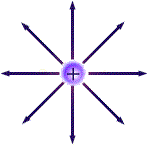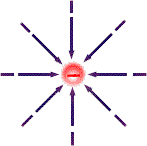Electric Field
Summary
Introduction
In the section on gravitation we studied the gravitational field. The electric field is analogous to this in many ways. Indeed it is this mathematical similarity of the equations used to describe the many different phenomina that we encounter that makes it possible to learn about all aspects of physics. Often we study seemingly different aspects of physics and find that they are described by the same mathematics.
Charge Types
Charge is a fundamental property of the universe. Most subatomic particles possess charge the most common being protons and electrons. Charges are either positive, neutral or negative.
A positive charge means that the object has lost electrons and is no longer electrically neutral. Each electron lost gives the particle a charge of +1.6 x 10-19 coulombs. Positive, or vitreous, charges are classically created by rubbing a glass rod with silk. The rod becomes positive (loses electrons); the silk become negative (gains electrons). Since electric charge is conserved, the system (glass rod and silk) maintains a net charge of 0.
A negative charge means that the object has gained electrons. Each electron gains gives the particle a charge of -1.6 x 10-19 coulombs. Negative, or resinous, charges are classically created by rubbing a rubber rod with fur. The rod becomes negatively charged; the fur positively charged. By definition, negatively charged objects have more mass than an identical neutral object since each extra electron has a mass of 9.11 x 10-31 kg.
Electrification by friction occurs when two surfaces are rubbed together. Examples of this were discussed above when a positive charge was created by rubbing glass with silk and a negative charge was created by rubbing rubber with fur. The following list details a larger portion of the triboelectric sequence. When any two substances shown in this list are rubbed together, the top one will become positively charged while the lower one will become negatively charged. The further apart the two substances are in the list, the greater the electrification.
| + | |
|---|---|
| Asbestos | |
| Fur (rabbit) | |
| Glass Mica | |
| Wool | |
| Quartz | |
| Fur (cat) | |
| Lead | |
| Silk | |
| Human skin, Aluminium | |
| Cotton | |
| Wood | |
| Amber | |
| Copper, Brass | |
| Rubber | |
| Sulphur | |
| Celluloid | |
| India Rubber | |
| - |
Table 1. Triboelectric series
Electric Field
The electric field measures the force per unit charge. Unlike gravity which can only be attractive the electric field can be attractive or repulsive depending on the sign of the charge. For positive charges, the field line always flow away from the charge, negative charges the field lines pull a positive charge toward it.
- They never start or stop in empty space – they stop or start either on a charge or “at infinity”.
- They never cross – if they did, a small positive charge placed there would feel forces in different directions, which could be resolved into the one true direction of the field line there.
- The density of field lines on a diagram is indicative of the strength of the field.
Electric Field of Point Charge Distributions
Positive Charge

Figure 1. Electric field from a positive charge
Negative Charge

Figure 2. Electric field from a negative charge
Dipole

Repulsive

The second diagram above also shows a point exactly between two like charges where no field exists (since the forces on a charge placed there would be exactly equal and opposite in direction). Such a point is called a neutral point.
Uniform Field

Coulomb's Law
If two charges are brought together then because of their charges they can exert either an attractive force or a repulsive force. The magnitude of the forces is proportional to the charge on the two point charges and it is also inversely proportional to the square of the of distance r separating the charges. In mathematical terms,

